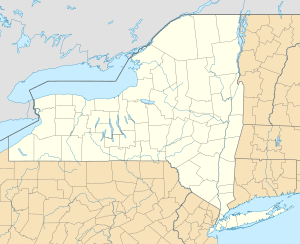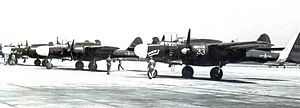Mitchel Air Force Base facts for kids
Quick facts for kids Mitchel Air Force Base
|
|
|---|---|
| Part of Air Defense Command | |
| Located near: Uniondale, New York | |

Looking west in 1968, the airfield is mainly intact.
|
|
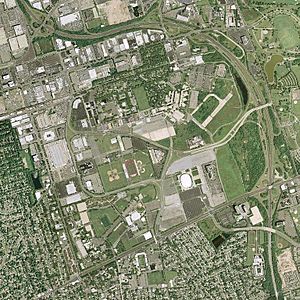
2006 USGS photo. The remains of runway 05/23 are visible in the center.
|
|
| Coordinates | 40°43′32″N 73°35′42″W / 40.72556°N 73.59500°W |
| Site history | |
| Built | 1917 |
| In use | 1917–1961 |
| Garrison information | |
| Occupants | |
|
Mitchel Air Base and Flight Line
|
|
| Location | Roughly Charles Lindbergh Blvd., Ellington Ave., East & West Rds., East Garden City, New York |
| Area | 108 acres (44 ha) |
| NRHP reference No. | 100002385 |
| Added to NRHP | May 4, 2018 |
|
Mitchel Field
|
|||||||||||||||||||||||
|---|---|---|---|---|---|---|---|---|---|---|---|---|---|---|---|---|---|---|---|---|---|---|---|
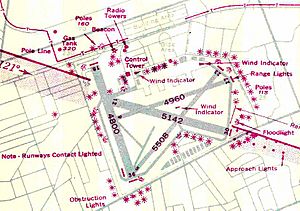 |
|||||||||||||||||||||||
| Summary | |||||||||||||||||||||||
| Opened | 1918 | ||||||||||||||||||||||
| Closed | June 25, 1961 | ||||||||||||||||||||||
| Elevation AMSL | 85 ft / 26 m | ||||||||||||||||||||||
| Runway | |||||||||||||||||||||||
|
|||||||||||||||||||||||
|
Source: Airfields-Freeman.com
|
|||||||||||||||||||||||
Mitchel Air Force Base, also known as Mitchel Field, was an important United States Air Force base. It was located on Long Island, New York. The base started in 1918 as Hazelhurst Aviation Field #2. Later that year, it was renamed Mitchel Field. This was to honor John Purroy Mitchel, a former New York City Mayor. He died while training for the Air Service in Louisiana.
The base closed in 1961. Today, the area is a busy place with many different uses. It is home to the Cradle of Aviation Museum, Nassau Coliseum, Mitchel Athletic Complex, Nassau Community College, and Hofstra University. In 2018, the remaining buildings and facilities were recognized as a historic district. They were added to the National Register of Historic Places.
Contents
History of Mitchel Field
Early Military Use
Before it was an airfield, this area had a long military history. During the American Revolutionary War, it was known as the Hempstead Plains. It was used as a place for the Army to sign up new soldiers. In the War of 1812 and the Mexican War, it became a training center for soldiers. During the American Civil War, it was called Camp Winfield Scott. Later, in 1898, during the Spanish–American War, the site was known as Camp Black.
World War I Aviation Training
In 1917, Hazelhurst Field #2 was created next to Hazelhurst Field. It was an extra training and storage base for the Air Service. Airplanes like the Curtiss JN-4 "Jennies" were often seen flying over Long Island. Hundreds of pilots learned to fly for the war at these large training fields. Many new buildings and tents were quickly built in 1918 to support this growth.
Growing Between the Wars
Mitchel Field continued to expand after World War I. Between 1929 and 1932, many new buildings were constructed. These changed the temporary wartime facilities into a permanent Army base. New barracks, warehouses, and hangars were built. Many of these buildings are still used today for other purposes.
In the 1920s and 1930s, different types of planes were based here. These included observation, fighter, and bomber units. It became a major airport for both the Army Air Corps and civilian flights. The 1920s were a "golden age" for air racing. On November 27, 1920, the Pulitzer Trophy Race was held at Mitchel Field. Pilots flew four laps around a 29-mile course. Captain Corliss Moseley won, flying at 156.54 miles per hour.
Mitchel Field saw many firsts in aviation. In October 1923, it hosted the first airplane jumping contest. That same year, two world speed records for airplanes were set there. In 1924, the airmail service began its first experimental flights from the airfield. In September 1929, Lt. Gen. James H. Doolittle made the world's first "blind flight." This meant he flew using only instruments, without seeing outside.
In 1938, Mitchel was the starting point for the first nonstop flight across the country by bomber planes. These were Army B-18 Bolo bombers. The base also showed how far planes could fly for scouting missions. In May 1939, three B-17 planes, guided by Lt. Curtis LeMay, flew 620 miles out to sea. They successfully found the Italian ocean liner SS Rex. This showed how powerful and accurate modern aviation was becoming. On September 21, 1939, the base was hit by a strong storm. This storm was called the ""Long Island Express" hurricane." Water was knee-deep, many trees fell, and the control tower's glass broke.
Mitchel Field During World War II
In 1940, Mitchel Field became home to the Aerospace Defense Command. This group was in charge of protecting cities, factories, and military bases in the United States. Later, the First Air Force took on the job of planning air defense for the East Coast. They set up plane patrols along the coast to watch for ships. During 1943, Mitchel AAF became a place where Consolidated B-24 Liberator bombers and their crews got ready. They would then be sent overseas to fight.
Mitchel Field was also key in supplying and defending air bases in Newfoundland, Greenland, and Iceland. From this airfield, plans were made for the air defense of Nova Scotia and Newfoundland. In 1942, planes from Mitchel flew antisubmarine patrols along the Atlantic coast. These planes searched for enemy submarines.
Under the First Air Force, Mitchel Army Airfield became a control center for fighter and bomber commands. Fighter groups and squadrons were formed at Mitchel. They trained at other bases before going to war zones. Thousands of Army Air Force personnel also passed through the base for combat duty overseas. After World War II ended, soldiers returning home were processed at Mitchel.
One incident during the war was a P-47 plane crash. It hit Hofstra University's Barnard Hall on March 23, 1943. In March 1946, the main office of the Air Defense Command moved to Mitchel Army Airfield.
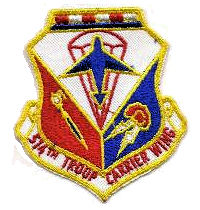
Mitchel Air Force Base and Its Closure
In 1947, the United States Air Force became its own separate military branch. Mitchel Army Airfield was then renamed Mitchel Air Force Base.
In December 1948, the Continental Air Command (ConAC) took over some defense duties. ConAC was also at Mitchel AFB. It was responsible for organizing the Air Force Reserve after World War II. By 1949, flying tactical aircraft in the city area became difficult. There was too much noise, the field was small, and there were safety worries. Because of this, Mitchel AFB was no longer responsible for defending New York's airspace.
The Army Anti-Aircraft Command moved to Mitchel AFB on November 1, 1950. The Air Defense Command headquarters later moved to Colorado in 1951. On November 29, 1952, President-elect Dwight D. Eisenhower flew from Mitchel Field to South Korea. This was to keep a promise he made during his election campaign. On January 2, 1954, Colonel W. Millikan set a speed record. He flew a North American F-86 Sabre across the country in 4 hours and 8 minutes, ending his flight at Mitchel AFB.
In April 1961, all flying activities stopped at the base. The 514th Troop Carrier Wing moved to McGuire Air Force Base in New Jersey. After this, Mitchel Air Force Base officially closed on June 25, 1961. The land was given to Nassau County for new development. Today, some military housing, a commissary, and exchange facilities still exist. These support military families in the area. A part of the Long Island Rail Road still ends in the northern part of Mitchel Field, sometimes carrying freight.
See also
- Roosevelt Field (airport)
- Nassau Inter-County Express § Mitchel Field Depot
- National Register of Historic Places listings in Hempstead (town), New York
- New York World War II Army airfields



